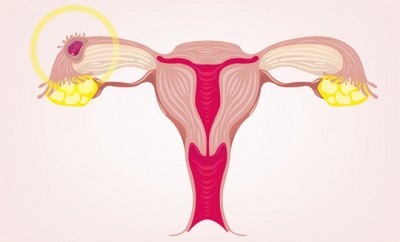Pink Vaginal Discharge Before Period: A Norm or Pathology?
Vaginal discharge is a normal protective reaction of the female organism. Its amount and physical characteristics depend on the menstrual cycle phase. Bloody discharge can be totally physiological and appear in the postpartum period, during ovulation and in the first trimester, after taking oral contraceptives or in case of the intrauterine device insertion.
However, it mustn`t be forgotten, that pink vaginal discharge can be the sign of serious hormonal disorders and inflammatory diseases, ectopic pregnancy and cervical erosion, endometrial hyperplasia, endometriosis, genital cancer and other diseases, connected with abnormalities of the genitourinary and other body systems. Therefore, if bloody discharge becomes regular and causes discomfort, it is necessary to see the competent specialist.
Pink Discharge Between Periods Can Indicate Ovulation
In the middle of the menstrual cycle an ovum is released from the ruptured follicle. It travels down to the fallopian tube, and then enters the uterus. In the majority of cases, women do not feel the process of ovulation. However, many of them report some discomfort in the lower abdomen and /or slight spotting. This process is called the ovulatory syndrome or mittelschmerz. If the egg is finally fertilized, pregnancy begins, and a woman has her missed period. If fertilization doesn`t occur, approximately 14 days later normal period starts.
This happens not in every menstrual cycle. Everything depends on the individual characteristics of the female body. If the ovulatory syndrome is clearly apparent and pink discharge is accompanied by severe pain and strong discomfort, these symptoms must be consulted with a specialist, who will help to avoid more serious complications during ovulation, e.g., heavy bleeding after the follicle rupture or hemorrhage in the ovaries.
Pink Discharge Before Period as a sign of Pregnancy
During implantation fertilized ovum migrates to the uterine cavity and embeds into endometrium (the inner layer of the uterus). Because of the increased hormone activity endometrium becomes well-supplied with blood and exactly at that moment of the egg implantation slight bleeding may occur. It is called implantation spotting and usually looks like a pink discharge. Due to the increase in progesterone level the fertilized ovum develops into the embryo and menstruation doesn`t occur. In case of successful implantation during the first trimester such pink discharge, slight or heavy, can indicate a miscarriage or a threatened abortion.
Pink Discharge in Case of Ectopic Pregnancy
Sometimes implantation of the fertilized egg can happen outside the uterine cavity, in places, which are inappropriate for further pregnancy development. More often it can happen in the fallopian tubes or on the cervix. If so, characteristic pink discharge appears along with the missed period, and home pregnancy tests still show just one line. In such a case it is strongly recommended to do the hCG blood test (measuring the level of the human chorionic gonadotropin), to make the ultrasound scan of the uterus and appendages, and to schedule appointment with your doctor.
Pink Discharge Can Be Caused by Contraception
To be more precise, pink discharge may be caused by hormonal contraceptives, which exist in the form of pills, patch, vaginal ring, intrauterine device and intradermal implant. Anyway, all of them cause some hormonal changes in the woman`s body: own natural hormones are replaced with the contraceptive ones, and this suppresses the process of ovulation. Very often hormonal contraceptives are prescribed for the treatment of different gynecological diseases.
Combined Oral Contraceptives Intake
If a woman takes combined oral contraceptives (COCs) without consulting with her gynecologist and any prescriptions (which is totally wrong), she can experience vaginal bleeding. This happens more often during the first three months of the COCs` intake. Pink discharge occurs suddenly, at any day of the menstrual cycle. More often it is a menstrual-like spotting. Organism tries to rebuild and adapt to its new hormone levels. Spotting is usually very slight and doesn`t last more than 2-3 days. After that menstrual-like bleeding begins. If pink discharge is prolonged and reoccurs more than 3 months in a row, your contraceptives are inappropriate for you. In this case, consult your doctor to obtain professional medical advice.
Intrauterine Device
The IUD can be either hormonal or non-hormonal. Anyway, its presence in the uterus should not cause any type of discomfort. Bloody discharge can indicate the wrong fixation of the intrauterine device, undesirable pregnancy beginning (more often the ectopic one) or hormonal imbalance. The pelvic ultrasound and gynecological consultation are necessary.
Mid-Cycle Pink Discharge Caused by Infections and Diseases
Every inflammatory process in the organism is characterized by the following common symptoms: redness, swelling, fever, pain and various dysfunctions. These processes take place at all levels, from the tiniest cells to the body as a whole. Pink discharge can also be the symptom of inflammation, as a result of infection or other diseases.
Gynecological Infections
Bloody discharge, caused by infections of the external or internal genitalia, is very common. First of all you need to take its consistency into account, to see whether it is mucous or purulent, accompanied with burning and itching sensations in the area of vaginal apertures.
In case of endometrial inflammations spotting can be either absolutely painless or accompanied by severe cramps in the abdomen and fever. To understand whether it is an inflammation or something else, you need to see a gynecologist and to make several examinations and tests.
Cervical Erosion
Painless pink discharge before menstruation, after period, at any day of the menstrual cycle, after sex or physical activity can be the sign of cervical erosion. This diagnosis can be confirmed only after the colposcopy examination.
Cancer
Exactly such painless, periodic, not menstrual-related pink discharge can be the sign of cancer. More often it is the endometrial or cervical cancer at later stages, in women aged premenopause and menopause (45 years and older). Therefore, it is important to have regular gynecological check-ups annually.
Hormonal Disorders
Pink discharge as a sign of the hormonal imbalance is a common phenomenon nowadays. It happens because of the stress, the abrupt climate change, heavy physical activity in the background of polycystic ovary syndrome, the presence of ovarian cysts, endometriosis, endometrial hyperplasia, hypothyroidism and other hormonal diseases of the reproductive and endocrine systems.
Diseases of the Associated Organs and Systems
Vaginal bleeding, not associated with hormonal balance disorders, may occur in case of the diabetes, blood coagulability problems, diseases of the hematopoietic system, rectovaginal or vesicovaginal fistula, kidney or liver diseases and other pathologies. To cope with these problems you need to consult with a highly-skilled specialist.
Conclusions
Some of the above-mentioned types of bleeding cannot be avoided, e.g. the ovulatory, implantation and premenstrual pink discharge. However, you can prevent most of the gynecological problems and get answers to your questions about your health with the help of timely and regular gynecological consultations and check-ups.
Recommended reading:
Spotting A Week Before Period: Should You Be Worried?
Implantation Bleeding or Period? 5 Leading Signs of Implantation Spotting
Signs Of Implantation: What To Look Out For
What Is Implantation Bleeding and When Does Implantation Bleeding Occur?
What Does Implantation Bleeding Look Like?
Can Implantation Bleeding Be Bright Red Key Facts Revealed












